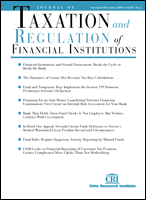Tax Aspects of Income Deposit Securities
Author: Peter A. Furci.
Source: Volume 18, Number 03, January/February 2005 , pp.32-47(16)

< previous article |next article > |return to table of contents
Abstract:
On December 10, 2003, Volume Services America Holdings, Inc. (now known as Centerplate) completed a $250 million offering of income deposit securities (IDSs), the first of its kind in the United States. The successful completion of this first IDS offering sparked significant interest in the investment banking and financial sponsor community, and by June 2004, nearly 20 issuers had filed registration statements with the Securities and Exchange Commission for similar offerings. However, the road for would-be IDS issuers proved to be more difficult than initially thought. As of this writing, only two issuers (B&G Foods and Coinmach Service Corp.) were able to successfully complete IDS offerings, while the number of registration statements relating to IDSs pending with the SEC has dwindled to less than ten. Furthermore, the time lag between Volume Services’ offering and B&G’s offering was eleven months, an eternity in capital markets time. Much of the difficulty in fulfilling the promise of IDSs lies with market conditions and SEC regulatory issues, a discussion of which is beyond the scope of this article. However, significant challenges to successfully structuring an IDS offering are presented by its tax consequences, in particular the fundamental and ancient question of debt vs. equity. This article attempts to provide some basic answers to a number of questions. What are IDSs? Where did they come from? Why are people interested in them? What are the key tax issues that arise in structuring these securities? This article will begin, by way of background, by discussing the immediate ancestor of IDSs, the Canadian income trust, followed by an overview of the IDSs themselves. It will then focus on two tax structuring issues in particular: first, an analysis of the debt component of the IDSs as indebtedness for tax purposes; and second, an analysis of the mechanism used to achieve fungibility for trading purposes of subsequently issued IDSs.Keywords:
Affiliations:
1: Debevoise & Plimpton LLP.